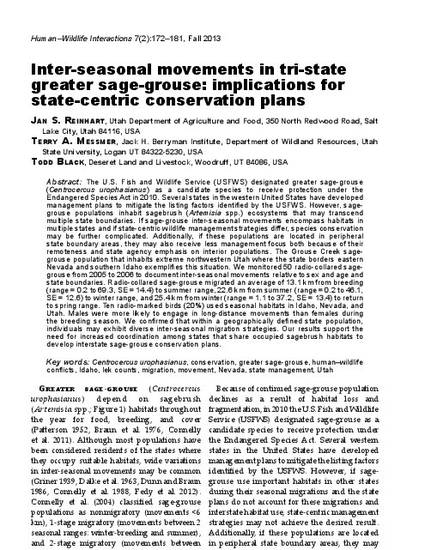
Article
Inter-Seasonal Movements in Tri-State Greater Sage-Grouse: Implications for State-Centric Conservation Plants
Human-Wildlife Interactions
(2013)
Abstract
The U.S. Fish and Wildlife Service (USFWS) designated greater sage-grouse (Centrocercus urophasianus) as a candidate species to receive protection under the Endangered Species Act in 2010. Several states in the western United States have developed management plans to mitigate the listing factors identi ed by the USFWS. However, sage- grouse populations inhabit sagebrush (Artemisia spp.) ecosystems that may transcend multiple state boundaries. If sage-grouse inter-seasonal movements encompass habitats in multiple states and if state-centric wildlife management strategies differ, species conservation may be further complicated. Additionally, if these populations are located in peripheral state boundary areas, they may also receive less management focus both because of their remoteness and state agency emphasis on interior populations. The Grouse Creek sage- grouse population that inhabits extreme northwestern Utah where the state borders eastern Nevada and southern Idaho exempli es this situation. We monitored 50 radio-collared sage- grouse from 2005 to 2006 to document inter-seasonal movements relative to sex and age and state boundaries. Radio-collared sage-grouse migrated an average of 13.1 km from breeding (range = 0.2 to 69.3, SE = 14.4) to summer range, 22.6 km from summer (range = 0.2 to 46.1, SE = 12.6) to winter range, and 25.4 km from winter (range = 1.1 to 37.2, SE = 13.4) to return to spring range. Ten radio-marked birds (20%) used seasonal habitats in Idaho, Nevada, and Utah. Males were more likely to engage in long-distance movements than females during the breeding season. We con rmed that within a geographically de ned state population, individuals may exhibit diverse inter-seasonal migration strategies. Our results support the need for increased coordination among states that share occupied sagebrush habitats to develop interstate sage-grouse conservation plans.
Disciplines
Publication Date
2013
Citation Information
Terry A. Messmer. "Inter-Seasonal Movements in Tri-State Greater Sage-Grouse: Implications for State-Centric Conservation Plants" Human-Wildlife Interactions Vol. 7 Iss. 2 (2013) p. 172 - 181 Available at: http://works.bepress.com/terry-messmer/314/
